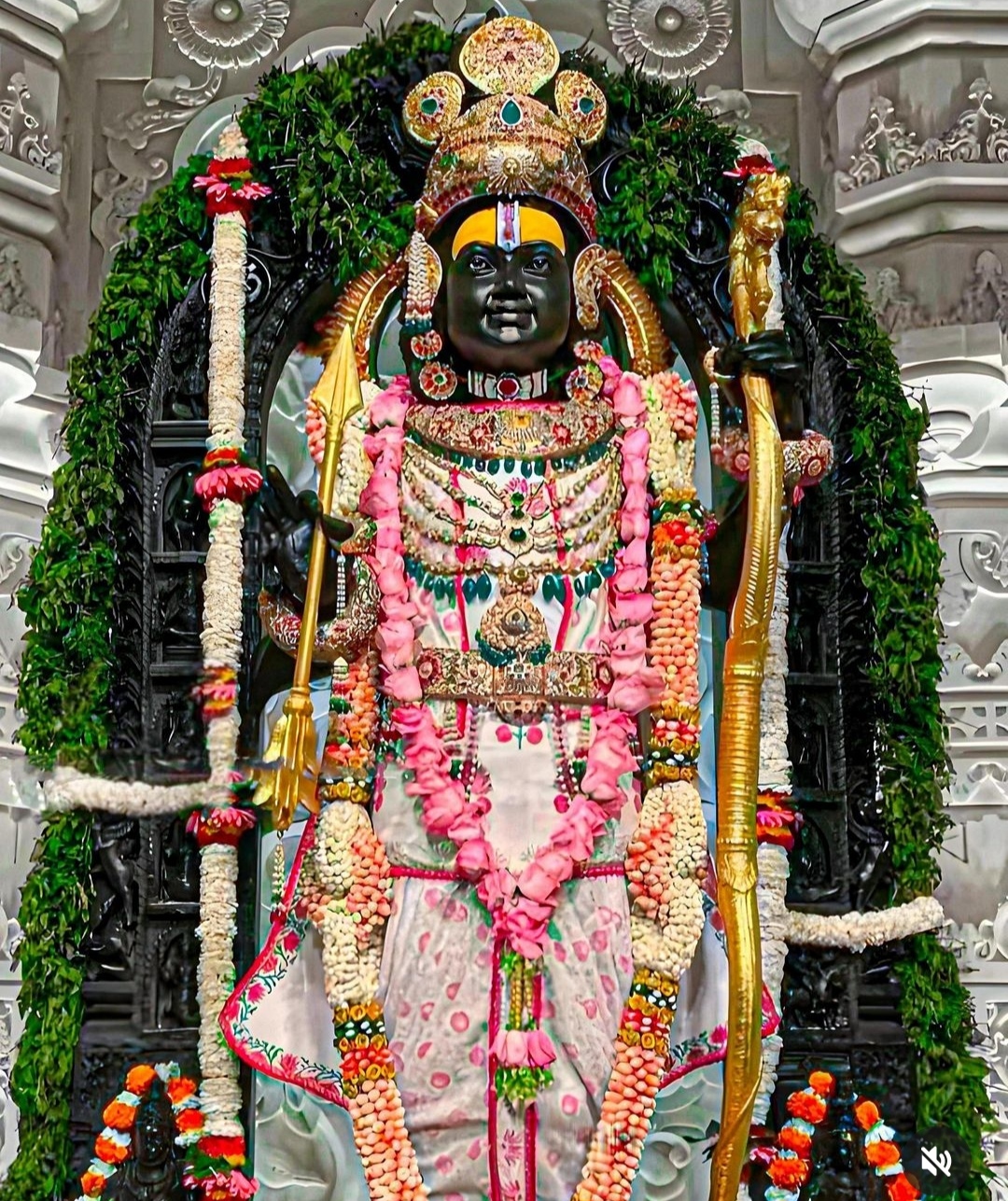Ram Navami in English
Ram Navami is a Hindu festival celebrated with great fervor and devotion to commemorate the birth of Lord Rama, the seventh incarnation of Lord Vishnu. Observed on the ninth day (Navami) of the Chaitra month in the Hindu lunar calendar, which typically falls in March or April, Ram Navami holds immense significance in Hindu mythology and tradition. This comprehensive exploration delves into the origins, religious significance, customs, rituals, and cultural aspects associated with Ram Navami, spanning 4500 words.
1. Origins of Ram Navami:
- Mythological Background: The celebration of Ram Navami is rooted in the ancient Indian epic, the Ramayana, which narrates the life and adventures of Lord Rama. According to Hindu mythology, Lord Rama was born to King Dasharatha and Queen Kaushalya in the city of Ayodhya.
- Significance of Lord Rama’s Birth: Lord Rama is revered as the epitome of righteousness (dharma) and the ideal human being (Maryada Purushottam). His birth symbolizes the triumph of good over evil and the victory of righteousness over wickedness.
- Historical Context: The tradition of celebrating Ram Navami dates back centuries and has been observed with religious fervor by Hindus across India and beyond.
2. Religious Significance:
- Devotional Observances: Ram Navami is marked by elaborate prayers, bhajans (devotional songs), and readings from the Ramayana, particularly the Ayodhya Kanda, which describes the events leading to Lord Rama’s birth.
- Fasting and Vrat: Many devout Hindus observe a fast (vrat) on Ram Navami as a mark of devotion and penance. Some may undertake a rigorous fast, abstaining from food and water until sunset, while others may opt for a partial fast or consume fruits and milk.
- Temple Celebrations: Temples dedicated to Lord Rama, such as the iconic Ram Janmabhoomi in Ayodhya, organize special pujas, processions, and cultural programs on Ram Navami. Devotees throng these temples to seek blessings and offer their prayers to the deity.
3. Customs and Rituals:
- Ram Katha Recitations: One of the central rituals of Ram Navami is the recitation of Ram Katha, the narrative of Lord Rama’s life and teachings. Spiritual leaders and storytellers often conduct elaborate discourses and recitations of the Ramayana during this time.
- Sita-Rama Kalyanam: In some regions, especially in South India, the marriage ceremony (Kalyanam) of Lord Rama and Goddess Sita is reenacted on Ram Navami. This symbolic ritual celebrates the divine union of the divine couple.
- Satsangs and Bhajan Mandalis: Communities organize satsangs (spiritual gatherings) and bhajan mandalis (devotional singing groups) to sing praises of Lord Rama and seek spiritual upliftment. These gatherings foster a sense of unity and devotion among participants.
4. Cultural Celebrations:
- Processions and Rathyatras: In several parts of India, especially in North India, colorful processions and rathyatras (chariot processions) are held on Ram Navami. Idols of Lord Rama, Goddess Sita, Lakshmana, and Hanuman are carried through the streets amidst chanting of hymns and slogans.
- Decorations and Rangoli: Homes, temples, and streets are adorned with intricate decorations, rangoli designs, and floral arrangements to welcome Lord Rama’s divine presence. The vibrant colors and festive ambiance add to the joyous atmosphere of Ram Navami celebrations.
- Community Service and Charity: Ram Navami is also a time for charitable activities and community service. Devotees engage in acts of seva (selfless service), such as feeding the needy, distributing prasad (sanctified food), and organizing medical camps.
5. Regional Variations:
- Ayodhya: As the birthplace of Lord Rama, Ayodhya is the epicenter of Ram Navami celebrations. The city is adorned with lights, flags, and decorative arches, and devotees flock to the banks of the Sarayu River to take holy dips and offer prayers.
- South India: In states like Tamil Nadu, Karnataka, and Andhra Pradesh, Ram Navami is celebrated with unique regional customs, including elaborate temple processions, cultural performances, and traditional rituals.
- Bengal: In West Bengal, Ram Navami is observed as part of the larger spring festival known as Basant Navratri. Devotees worship Lord Rama and Goddess Sita with fervor, and processions featuring tableau depicting scenes from the Ramayana are organized.
6. Contemporary Relevance:
- Unity in Diversity: Ram Navami transcends regional, linguistic, and cultural barriers, uniting Hindus from diverse backgrounds in a shared celebration of faith and devotion.
- Message of Virtue and Righteousness: The life and teachings of Lord Rama continue to inspire millions worldwide, serving as a beacon of moral values, courage, and compassion.
- Interfaith Harmony: Ram Navami celebrations often promote interfaith dialogue and harmony, fostering mutual respect and understanding among different religious communities.
7. Conclusion:
- Ram Navami is not just a religious festival but a cultural phenomenon that celebrates the timeless values embodied by Lord Rama. Through its rich traditions, customs, and rituals, Ram Navami reinforces the eternal message of righteousness, compassion, and devotion that resonates across generations.
- As devotees come together to celebrate the auspicious occasion of Ram Navami, they reaffirm their faith in the divine and draw inspiration from the life and teachings of Lord Rama, guiding them on the path of virtue and spiritual enlightenment.
In Hindi
राम नवमी: भगवान राम के जन्म का जश्न मनाना
राम नवमी एक हिंदू त्योहार है जो भगवान विष्णु के सातवें अवतार भगवान राम के जन्म के उपलक्ष्य में बड़े उत्साह और भक्ति के साथ मनाया जाता है। हिंदू चंद्र कैलेंडर में चैत्र महीने के नौवें दिन (नवमी) को मनाया जाता है, जो आम तौर पर मार्च या अप्रैल में पड़ता है, राम नवमी हिंदू पौराणिक कथाओं और परंपरा में बहुत महत्व रखती है। यह व्यापक अन्वेषण 4500 शब्दों में रामनवमी से जुड़ी उत्पत्ति, धार्मिक महत्व, रीति-रिवाजों, रीति-रिवाजों और सांस्कृतिक पहलुओं पर प्रकाश डालता है।
1. रामनवमी की उत्पत्ति:
- *पौराणिक पृष्ठभूमि:* राम नवमी का उत्सव प्राचीन भारतीय महाकाव्य, रामायण में निहित है, जो भगवान राम के जीवन और साहसिक कार्यों का वर्णन करता है। हिंदू पौराणिक कथाओं के अनुसार, भगवान राम का जन्म राजा दशरथ और रानी कौशल्या के घर अयोध्या शहर में हुआ था।
- *भगवान राम के जन्म का महत्व:* भगवान राम को धर्म के प्रतीक और आदर्श मानव (मर्यादा पुरूषोत्तम) के रूप में पूजा जाता है। उनका जन्म बुराई पर अच्छाई की विजय और दुष्टता पर धर्म की जीत का प्रतीक है।
- *ऐतिहासिक संदर्भ:* राम नवमी मनाने की परंपरा सदियों पुरानी है और इसे पूरे भारत और उसके बाहर के हिंदुओं द्वारा धार्मिक उत्साह के साथ मनाया जाता है।2. धार्मिक महत्व:
- *भक्तिपूर्ण उत्सव:* राम नवमी को विस्तृत प्रार्थनाओं, भजनों (भक्ति गीतों) और रामायण, विशेष रूप से अयोध्या कांड के पाठ के साथ चिह्नित किया जाता है, जिसमें भगवान राम के जन्म की घटनाओं का वर्णन किया गया है।
- *उपवास और व्रत:* कई धर्मनिष्ठ हिंदू भक्ति और तपस्या के प्रतीक के रूप में राम नवमी पर उपवास रखते हैं। कुछ लोग कठोर उपवास कर सकते हैं, सूर्यास्त तक भोजन और पानी से परहेज कर सकते हैं, जबकि अन्य आंशिक उपवास का विकल्प चुन सकते हैं या फल और दूध का सेवन कर सकते हैं।
- *मंदिर उत्सव:* भगवान राम को समर्पित मंदिर, जैसे कि अयोध्या में प्रतिष्ठित राम जन्मभूमि, राम नवमी पर विशेष पूजा, जुलूस और सांस्कृतिक कार्यक्रम आयोजित करते हैं। भक्त आशीर्वाद लेने और देवता से प्रार्थना करने के लिए इन मंदिरों में आते हैं।3. रीति-रिवाज़ एवं अनुष्ठान:
- *राम कथा पाठ:* राम नवमी के केंद्रीय अनुष्ठानों में से एक राम कथा का पाठ है, जो भगवान राम के जीवन और शिक्षाओं की कथा है। आध्यात्मिक नेता और कथावाचक अक्सर इस दौरान रामायण के विस्तृत प्रवचन और पाठ करते हैं।
- *सीता-राम कल्याणम:* कुछ क्षेत्रों में, विशेष रूप से दक्षिण भारत में, राम नवमी पर भगवान राम और देवी सीता का विवाह समारोह (कल्याणम) दोहराया जाता है। यह प्रतीकात्मक अनुष्ठान दिव्य जोड़े के दिव्य मिलन का जश्न मनाता है।
- *सत्संग और भजन मंडलियां:* समुदाय भगवान राम की स्तुति गाने और आध्यात्मिक उत्थान के लिए सत्संग (आध्यात्मिक सभाएं) और भजन मंडलियां (भक्ति गायन समूह) आयोजित करते हैं। ये सभाएँ प्रतिभागियों के बीच एकता और भक्ति की भावना को बढ़ावा देती हैं।4. सांस्कृतिक उत्सव:
- *जुलूस और रथयात्रा:* भारत के कई हिस्सों में, विशेष रूप से उत्तर भारत में, राम नवमी पर रंगीन जुलूस और रथयात्रा (रथ जुलूस) आयोजित किए जाते हैं। भगवान राम, देवी सीता, लक्ष्मण और हनुमान की मूर्तियों को भजनों और नारों के बीच सड़कों पर ले जाया जाता है।
- *सजावट और रंगोली:* भगवान राम की दिव्य उपस्थिति का स्वागत करने के लिए घरों, मंदिरों और सड़कों को जटिल सजावट, रंगोली डिजाइन और फूलों की सजावट से सजाया जाता है। जीवंत रंग और उत्सव का माहौल रामनवमी समारोह के आनंदमय माहौल को बढ़ाते हैं।
- *सामुदायिक सेवा और दान:* राम नवमी धर्मार्थ गतिविधियों और सामुदायिक सेवा का भी समय है। भक्त सेवा (निःस्वार्थ सेवा) के कार्यों में संलग्न होते हैं, जैसे जरूरतमंदों को खाना खिलाना, प्रसाद (पवित्र भोजन) वितरित करना और चिकित्सा शिविर आयोजित करना।5. क्षेत्रीय विविधताएँ:
- *अयोध्या:* भगवान राम की जन्मभूमि के रूप में, अयोध्या राम नवमी समारोह का केंद्र है। शहर को रोशनी, झंडों और सजावटी मेहराबों से सजाया गया है, और भक्त पवित्र स्नान करने और प्रार्थना करने के लिए सरयू नदी के तट पर आते हैं।
- *दक्षिण भारत:* तमिलनाडु, कर्नाटक और आंध्र प्रदेश जैसे राज्यों में, राम नवमी को अद्वितीय क्षेत्रीय रीति-रिवाजों के साथ मनाया जाता है, जिसमें विस्तृत मंदिर जुलूस, सांस्कृतिक प्रदर्शन और पारंपरिक अनुष्ठान शामिल हैं।
- *बंगाल:* पश्चिम बंगाल में, राम नवमी को बसंत नवरात्रि के नाम से जाने जाने वाले बड़े वसंत उत्सव के हिस्से के रूप में मनाया जाता है। भक्त उत्साह के साथ भगवान राम और देवी सीता की पूजा करते हैं, और रामायण के दृश्यों को दर्शाती झांकियों वाले जुलूस आयोजित किए जाते हैं।6. समसामयिक प्रासंगिकता:
- *विविधता में एकता:* राम नवमी क्षेत्रीय, भाषाई और सांस्कृतिक बाधाओं को पार करती है, विभिन्न पृष्ठभूमि के हिंदुओं को आस्था और भक्ति के साझा उत्सव में एकजुट करती है।
- *सदाचार और धार्मिकता का संदेश:* भगवान राम का जीवन और शिक्षाएं नैतिक मूल्यों, साहस और करुणा के प्रतीक के रूप में काम करते हुए दुनिया भर में लाखों लोगों को प्रेरित करती रहती हैं।
- *अंतरधार्मिक सद्भाव:* राम नवमी समारोह अक्सर अंतरधार्मिक संवाद और सद्भाव को बढ़ावा देते हैं, विभिन्न धार्मिक समुदायों के बीच आपसी सम्मान और समझ को बढ़ावा देते हैं।सात निष्कर्ष:*
- राम नवमी सिर्फ एक धार्मिक त्योहार नहीं है बल्कि एक सांस्कृतिक घटना है जो भगवान राम द्वारा सन्निहित शाश्वत मूल्यों का जश्न मनाती है। अपनी समृद्ध परंपराओं, रीति-रिवाजों और अनुष्ठानों के माध्यम से, राम नवमी धार्मिकता, करुणा और भक्ति के शाश्वत संदेश को पुष्ट करती है जो पीढ़ियों तक गूंजती रहती है।
- जैसे ही भक्त राम नवमी के शुभ अवसर को मनाने के लिए एक साथ आते हैं, वे परमात्मा में अपनी आस्था की पुष्टि करते हैं और भगवान राम के जीवन और शिक्षाओं से प्रेरणा लेते हैं, उन्हें सदाचार और आध्यात्मिक ज्ञान के मार्ग पर मार्गदर्शन करते हैं।
















Great read! I appreciate the effort you put into researching this.
Thanks for breaking this down into easy-to-understand terms.